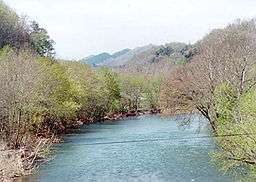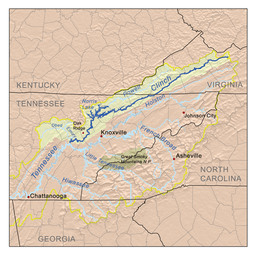Clinch River
| Clinch River | |
| River | |
 The Clinch River at Speers Ferry in Scott County, Virginia | |
| Country | United States |
|---|---|
| States | Virginia, Tennessee |
| Tributaries | |
| - left | Little River, Beaver Creek |
| - right | Guest River, North Fork Clinch River, Powell River, Coal Creek, Poplar Creek, Emory River |
| Source | Buckhorn Mountain near Tazewell, Virginia |
| - elevation | 2,760 ft (841 m) [1] |
| - coordinates | 37°08′29″N 81°27′41″W / 37.14139°N 81.46139°W [1] |
| Mouth | Tennessee River at Kingston, Tennessee |
| - elevation | 741 ft (226 m) [1] |
| - coordinates | 35°51′48″N 84°31′54″W / 35.86333°N 84.53167°WCoordinates: 35°51′48″N 84°31′54″W / 35.86333°N 84.53167°W [1] |
| Length | 337 mi (542 km) [2] |
| Basin | 4,413 sq mi (11,430 km2) [3] |
| Discharge | for Grissom Island near Tazewell, Tennessee, 159.8 miles (257.2 km) above the mouth |
| - average | 2,100 cu ft/s (59 m3/s) (mean for water years 1918-1983)[4] |
| - max | 98,100 cu ft/s (2,778 m3/s) April 1977[4] |
| - min | 108 cu ft/s (3.1 m3/s) September 1925[4] |
 Clinch River watershed
| |
The Clinch River rises near Tazewell, Virginia, and flows southwest for more than 300 miles (480 km) through the Great Appalachian Valley, gathering various tributaries, including the Powell River, before joining the Tennessee River in Kingston, Tennessee.
Course
The Clinch River is dammed twice: by Norris Dam, the first dam built by the Tennessee Valley Authority (TVA); and by the Melton Hill Dam, the only TVA dam with a navigation lock that is not located on the main channel of the Tennessee River.
An important tributary of the Clinch River is the Powell River. The Clinch and Powell River drainage basins are separated by Powell Mountain. Tributaries entering the Clinch River below Norris Dam but above Melton Hill Dam include Coal Creek, Hinds Creek, Bull Run Creek, and Beaver Creek. Poplar Creek enters the river below the Melton Hill Dam.
History
A peninsula located at the mouth of the Clinch River, called Southwest Point, was the site of an early frontier fort which has been recently reconstructed. This site was important to Native Americans. A treaty between the Cherokees and the white settlers was signed at Southwest Point, allowing the Capital of Tennessee to be moved there. The Tennessee General Assembly fulfilled this requirement technically by meeting in Kingston for one day, and then voting to move the capital city elsewhere.
Clinch was the name of an 18th-century explorer of the area.[5] Old names for the river include "Clinch's River" and "Pelisipi River" (and variant spellings such as "Pelisippi" and "Pellissippi").[1] The name Pellissippi that appears on some early maps is said to have been the Cherokees' name for the river and is said to mean "winding waters" in the Cherokee language.[6] (The name Pellissippi has been used throughout East Tennessee, for example in Pellissippi Parkway and Pellissippi State Community College.)
A huge coal-fired power plant sits on the Clinch River at Carbo in Russell County, Virginia. It was completed in 1957, and it is owned by Appalachian Power, a part of American Electric Power. On June 25, 2008, permits were approved by the state Air Pollution Control Board for another coal-fired power plant, a few miles away outside St. Paul, Virginia, by Dominion Virginia Power.
Pollution from mining in the region has caused great concern among environmentalists because several rare species inhabit the river. Some mussels were reintroduced to the Cleveland, Virginia area from outside the state in the early 2000s after pollution in the 20th century wiped out much of the population.
In 2008, a large release of fly ash from the TVA's Kingston Fossil Plant deposited fly ash in the lower section of the river below the confluence of the Emory River.
Ecology
The Clinch River above Clinton, Tennessee (tailwaters of Norris Dam) is stocked with rainbow trout and brown trout by the Tennessee Wildlife Resources Agency.
Before being dammed, the Clinch River was a major producer of freshwater mussels and pearls. The rivers of the southern Appalachians are still notable for their unusually rich mussel biodiversity. The mussels were an important food source for Native Americans and were later used by settlers as bait and hog feed. The freshwater pearl industry thrived throughout the southern Appalachians in the late 19th century and early 20th century. The Clinch River and the Emory River were considered the economic heart of the pearl industry, and the state of Tennessee was one of the top six states in the United States for pearl production. The mussel-based industries began to decline in the early 20th century and were effectively eliminated by the dams built by the TVA. The first major Tennessee River dam was Wilson Dam, built at a site known as Muscle Shoals, referring to the freshwater mussels of the region. Norris Dam and Norris Lake on the Clinch River flooded one of the other areas of mussel near Young's Island.[7]
Recreation
There are several state and local parks along the Clinch River in both Tennessee and Virginia.
State Parks in Tennessee include:
- Big Ridge State Park
- Norris Dam State Park
- Chuck Swan State Forest
See also
References
- 1 2 3 4 5 U.S. Geological Survey Geographic Names Information System: Clinch River
- ↑ This figure was obtained by adding the length of the Tennessee section of the river, indicated on the USGS topo map Looneys Gap (1:24,000) as just over 202 miles, to the length of the Virginia section, indicated as 135 miles at this Virginia Department of Game and Inland Fisheries website.
- ↑ U.S. Geological Survey, "Introduction to the Upper Tennessee River Basin," 11 January 2013. Accessed: 5 June 2015.
- 1 2 3 United States Geological Survey, Water Resources Data Tennessee: Water Year 1983, Water Data Report TN-83-1, p. 131. Gaging station 03528000.
- ↑ Collins, Lewis (1877). History of Kentucky. p. 416.
- ↑ "The Pellissippi State Story 1974-1998". Pellissippi State Community College. Archived from the original on November 3, 2013. Retrieved July 24, 2013. Note: The Cherokee origin of "Pellissippi" is questionable, as there is no “P” sound in the Cherokee syllabary (D. Ray Smith. "View of the Bear Creek Valley". Retrieved July 24, 2013.).
- ↑ Davis, Donald Edward. "Where There Are Mountains, An Environmental History of the Southern Appalachians". University of Georgia Press: 2005.
External links
| Wikimedia Commons has media related to Clinch River. |
- Columbia Gazetteer of North America
- U.S. Geological Survey Geographic Names Information System: Clinch River
- Pellissippi Blueway
-
 "Clinch River". New International Encyclopedia. 1905.
"Clinch River". New International Encyclopedia. 1905.